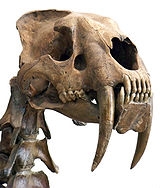
Saber-toothed cat
Overview
Machairodontinae
Machairodontinae is an extinct carnivoran mammal subfamily of Felidae endemic to Asia, Africa, North America, South America, and Europe from the Miocene to Pleistocene living from c. 23 Ma until c...
(Felidae
Felidae
Felidae is the biological family of the cats; a member of this family is called a felid. Felids are the strictest carnivores of the thirteen terrestrial families in the order Carnivora, although the three families of marine mammals comprising the superfamily pinnipedia are as carnivorous as the...
), Barbourofelidae
Barbourofelidae
Barbourofelidae is an extinct family of mammalian carnivores of the suborder Feliformia, which lived in North America, Eurasia and Africa during the Miocene epoch , existing for approximately .- Taxonomy :...
(Feliformia
Feliformia
The Feliformia are a suborder within the order Carnivora and includes cats , hyenas, mongooses, civets and related taxa. The other suborder of Carnivora is Caniformia...
), and Nimravidae
Nimravidae
The Nimravidae, sometimes known as false saber-toothed cats, are an extinct family of mammalian carnivores belonging to the suborder Feliformia and endemic to North America, Europe, and Asia living from the Eocene through the Miocene epochs , existing for approximately .-Morphology:Although some...
(Feliformia) as well as two families related to marsupial
Marsupial
Marsupials are an infraclass of mammals, characterized by giving birth to relatively undeveloped young. Close to 70% of the 334 extant species occur in Australia, New Guinea, and nearby islands, with the remaining 100 found in the Americas, primarily in South America, but with thirteen in Central...
s that were found worldwide from the Eocene
Eocene
The Eocene Epoch, lasting from about 56 to 34 million years ago , is a major division of the geologic timescale and the second epoch of the Paleogene Period in the Cenozoic Era. The Eocene spans the time from the end of the Palaeocene Epoch to the beginning of the Oligocene Epoch. The start of the...
Epoch to the end of the Pleistocene
Pleistocene
The Pleistocene is the epoch from 2,588,000 to 11,700 years BP that spans the world's recent period of repeated glaciations. The name pleistocene is derived from the Greek and ....
Epoch (42 mya—11,000 years ago), existing for approximately . They are so called for their large, saber-like maxillary canine
Maxillary canine
The maxillary canine is the tooth located laterally from both maxillary lateral incisors of the mouth but mesial from both maxillary first premolars...
teeth, which extended from their mouths even when it was closed.
Unanswered Questions

